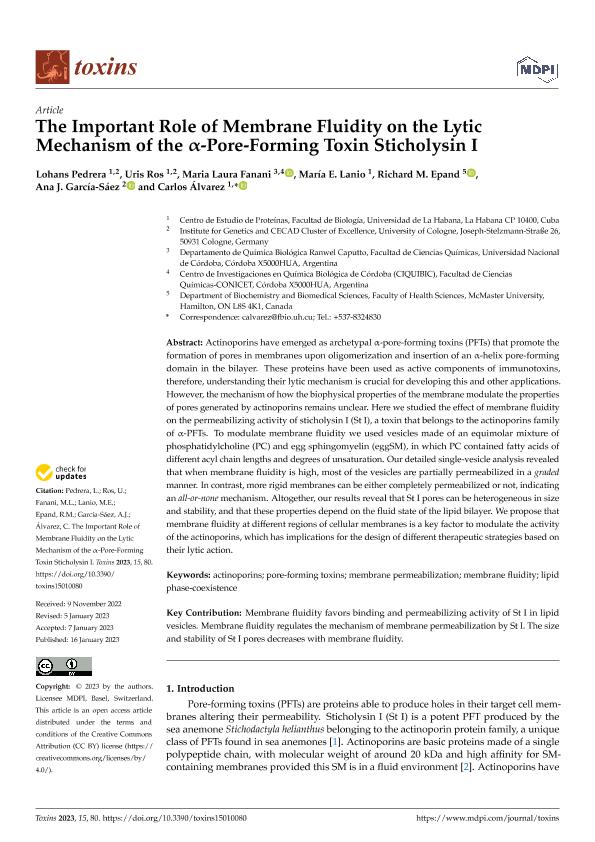Mostrar el registro sencillo del ítem
dc.contributor.author
Pedrera, Lohans
dc.contributor.author
Ros, Uris
dc.contributor.author
Fanani, Maria Laura

dc.contributor.author
Lanio, María E.
dc.contributor.author
Epand, Richard M.
dc.contributor.author
García-Sáez, Ana J.
dc.contributor.author
Álvarez, Carlos
dc.date.available
2023-12-01T14:40:57Z
dc.date.issued
2023-01
dc.identifier.citation
Pedrera, Lohans; Ros, Uris; Fanani, Maria Laura; Lanio, María E.; Epand, Richard M.; et al.; The important role of membrane fluidity on the lytic mechanism of the α-Pore-Forming Toxin Sticholysin I; MDPI; Toxins; 15; 1; 1-2023; 80-99
dc.identifier.uri
http://hdl.handle.net/11336/218992
dc.description.abstract
Actinoporins have emerged as archetypal α-pore-forming toxins (PFTs) that promote the formation of pores in membranes upon oligomerization and insertion of an α-helix pore-forming domain in the bilayer. These proteins have been used as active components of immunotoxins, therefore, understanding their lytic mechanism is crucial for developing this and other applications. However, the mechanism of how the biophysical properties of the membrane modulate the properties of pores generated by actinoporins remains unclear. Here we studied the effect of membrane fluidity on the permeabilizing activity of sticholysin I (St I), a toxin that belongs to the actinoporins family of α-PFTs. To modulate membrane fluidity we used vesicles made of an equimolar mixture of phosphatidylcholine (PC) and egg sphingomyelin (eggSM), in which PC contained fatty acids of different acyl chain lengths and degrees of unsaturation. Our detailed single-vesicle analysis revealed that when membrane fluidity is high, most of the vesicles are partially permeabilized in a graded manner. In contrast, more rigid membranes can be either completely permeabilized or not, indicating an all-or-none mechanism. Altogether, our results reveal that St I pores can be heterogeneous in size and stability, and that these properties depend on the fluid state of the lipid bilayer. We propose that membrane fluidity at different regions of cellular membranes is a key factor to modulate the activity of the actinoporins, which has implications for the design of different therapeutic strategies based on their lytic action.
dc.format
application/pdf
dc.language.iso
eng
dc.publisher
MDPI
dc.rights
info:eu-repo/semantics/openAccess
dc.rights.uri
https://creativecommons.org/licenses/by-nc-sa/2.5/ar/
dc.subject
ACTINOPORINS
dc.subject
LIPID PHASE-COEXISTENCE
dc.subject
MEMBRANE FLUIDITY
dc.subject
MEMBRANE PERMEABILIZATION
dc.subject
PORE-FORMING TOXINS
dc.subject.classification
Biofísica

dc.subject.classification
Ciencias Biológicas

dc.subject.classification
CIENCIAS NATURALES Y EXACTAS

dc.title
The important role of membrane fluidity on the lytic mechanism of the α-Pore-Forming Toxin Sticholysin I
dc.type
info:eu-repo/semantics/article
dc.type
info:ar-repo/semantics/artículo
dc.type
info:eu-repo/semantics/publishedVersion
dc.date.updated
2023-11-29T13:21:20Z
dc.identifier.eissn
2072-6651
dc.journal.volume
15
dc.journal.number
1
dc.journal.pagination
80-99
dc.journal.pais
Países Bajos

dc.journal.ciudad
Amsterdam
dc.description.fil
Fil: Pedrera, Lohans. Universidad de La Habana; Cuba. Universitat zu Köln; Alemania
dc.description.fil
Fil: Ros, Uris. Universidad de La Habana; Cuba. Universitat zu Köln; Alemania
dc.description.fil
Fil: Fanani, Maria Laura. Universidad Nacional de Córdoba; Argentina. Consejo Nacional de Investigaciones Científicas y Técnicas. Centro Científico Tecnológico Conicet - Córdoba. Centro de Investigaciones en Química Biológica de Córdoba. Universidad Nacional de Córdoba. Facultad de Ciencias Químicas. Centro de Investigaciones en Química Biológica de Córdoba; Argentina
dc.description.fil
Fil: Lanio, María E.. Universidad de La Habana; Cuba
dc.description.fil
Fil: Epand, Richard M.. Mcmaster University, Faculty Of Health Sciences; Canadá
dc.description.fil
Fil: García-Sáez, Ana J.. Universitat zu Köln; Alemania
dc.description.fil
Fil: Álvarez, Carlos. Universidad de La Habana; Cuba
dc.journal.title
Toxins
dc.relation.alternativeid
info:eu-repo/semantics/altIdentifier/doi/http://dx.doi.org/10.3390/toxins15010080
dc.relation.alternativeid
info:eu-repo/semantics/altIdentifier/url/https://www.mdpi.com/2072-6651/15/1/80
Archivos asociados
